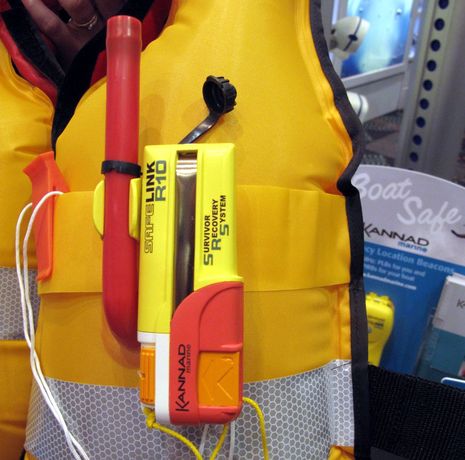AIS MOB: Kannad SafeLink R10 & McMurdo SmartFind S10

New in Miami were both the Kannad brand and its interesting AIS-based SafeLink R10 "survivor recovery system." And more sorting out was in order when your realized that McMurdo was showing the very similar SmartFind S10 in the very same booth. Note too how the Kannad SafeLink PLB in the background looks a heck of lot like the popular McMurdo FastFind. What's going on is that Kannad, a longtime French distress beacon company, became a sibling to McMurdo when Orolia bought both of them, and now they're working as partners in a somewhat overlapped fashion...
In fact, the two "personal AIS beacons" -- or PABs if you like McMurdo's terminology, and I do -- contain exactly the same core technology, which is to say that they are small versions of the AIS SARTs that were discussed here a bit last year. The difference is that the Kannad model can be fitted to a lifejacket so that it is automatically activated when the jacket inflates, while the McMurdo model is rated to 60 meter depths (instead of 5) so that it can carried by serious divers. As I understand it those differences reflect how Kannad will be positioned as a recreational marine brand while McMurdo gets a more commercial orientation. Though I should note that you can't buy either one of these PABs in the U.S. until they're approved by the FCC, and then they will retail for $350.I do like the idea of a MOB system that includes GPS location and can be seen by your own boat and others close by, as long as they are plotting AIS targets. But I think it will be a while before many onboard AIS plotters are programmed to alarm an AIS SART sighting (though I did see it on a Vesper Watchmate), and I've yet to see any reports about how well AIS SART technology works when used by a someone in the water as opposed to being in a lifeboat or raft. There's also competition with DSC VHF MOB solutions, like the BriarTek ORCAdsc, which can potentially deliver GPS location and a loud alarm to most any boat around. An issue with the ORCA, as noted in my entry about it, is that U.S. authorities don't want these devices to set off every DSC alarm in the vicinity, but I understand that a new ruling is in the works that will let them alarm their own boat for 30 minutes or so, and then all boats. It's amazing actually how many different MOB retrieval systems there are, and what an active niche it is, as witnessed by today's merger of Mobilarm and Marine Rescue Technologies.

 Share
Share
Ben, any thoughts on how these stack up relative to Weather Dock's easyRESCUE? Col